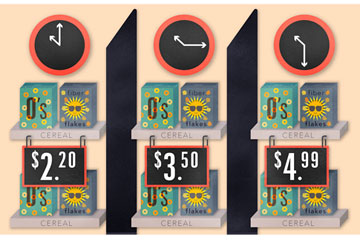
Maybe you didn't notice it in the Christmas crush, but a huge shift took place this holiday shopping season: merchants changed the price of goods online more quickly than at any other time in retail history. How often? According to Eric Best, CEO of Mercent, a Seattle firm that creates and manages automated pricing programs, the most aggressive sellers were jiggling prices in 10-to-15-minute windows. That's why they call it dynamic pricing.
You're probably most familiar with dynamic pricing from buying airline tickets. The model, introduced by American Airlines in the '80s, is designed to shift capacity risk (i.e., empty seats) from the airline to you in exchange for a discount on the full fare while giving the carrier a better shot at a profit. It works in that you can pretty much always find a seat, even if you end up paying twice the price of the passenger next to you. Win some, lose some.
More and more businesses are adopting this model. Sports teams like the St. Louis Cardinals once charged the same amount for the same seats at every game. But demand for a Saturday-night matchup with Philadelphia is greater than for a Thursday-afternoon contest with San Diego. So the Cards tease the price to attract the most customers, just like airlines, because if a seat goes empty, the revenue is lost forever. (In one sense, the Cards are replacing the scalpers' market outside the stadium.) Theaters, golf courses and other businesses with time-perishable inventories are doing likewise.
Now the action is moving deeper in retailing, setting up a battle between consumers wielding shopbots like mySimon and algorithm-armed sellers and resellers. The retailers are trying to avoid losing value. Lego's Epic Dragon Battle, for instance, has a manufacturer's suggested retail price (MSRP) of $119. But the toy's so hot, Amazon sellers are pricing it closer to $140, which means Lego is leaving money on the table. That's why some merchants are abandoning MSRPs, instead setting a floor and letting dynamic-pricing programs take over. They monitor variables such as inventory levels, item velocity, competitors' pricing and advertising. "The effort that the consumer had to go through in an eBay auction has been taken on by the retailer," says Best, a former Amazon executive. "They are the ones that are determining perfect market value." (Some sellers are also looking at behavioral variables by tracking your Web searches. That's more controversial, but you can prevent them from doing it.)
The good thing for us is that pricing engines have to compete with one another and with our ability to gather information. And Amazon and Google want to kill each other, bringing pricing transparency to most products. That leaves sellers with the choice of being hyperefficient and duking it out on the price front, like Walmart and Amazon, or offering unique products and experiences, á la Apple and Disney. It's a future in which many transactions--for milk, Uggs, baseball tickets--could follow the stock market's bid/ask system. Think electronic price tags in brick-and-mortar stores that change as you approach, on the basis of your shopping history. Also gaining: consumer intermediaries like Decide.com that allow you to reverse-engineer the price engines. They predict the price of a camera, say, and recommend that you buy it at a certain amount; if you do and the price drops, they'll pay you the difference. Some credit cards are offering price protection too. So is Target.
Pricing expert John Zhang of the Wharton School at the University of Pennsylvania says retailing is coming full circle. Before supermarkets, merchants--from Middle Eastern suqs to London shops--sized up their customers and priced goods accordingly. They cut personalized deals and made trade-offs. Today's merchants simply use a different method. "Personal-identification storage technology has enabled the sellers to go back into the dynamic pricing they were doing for a century," Zhang says. Expect it in the frozen-food aisle soon.
